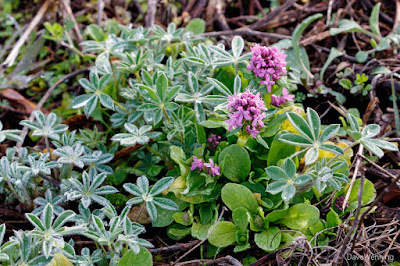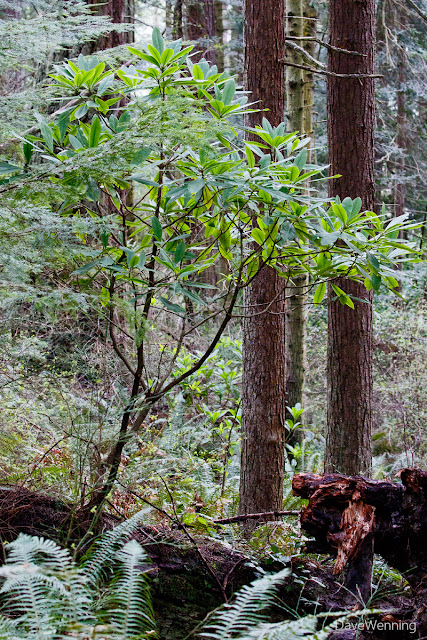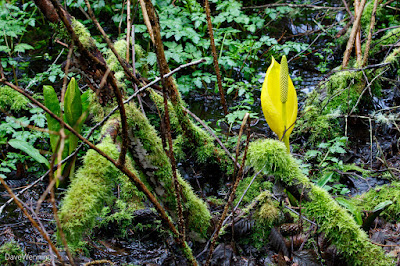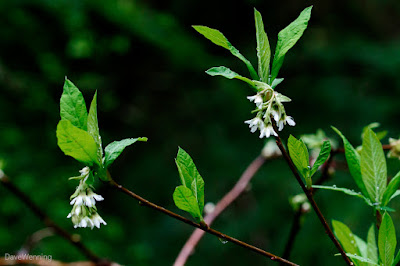Now Showing and Coming Attractions
It's early March, and already spring is definitely under way at Deception Pass State Park. In the West Beach sand dunes, I found this pink Sea Blush (Plectritis congesta) in the company of Seashore Lupine (Lupinus littoralis). Both are hugging the ground to try and escape the winds off the Strait of Juan de Fuca. I was surprised to find this one plant already blooming. This reveals that the dunes will be washed in pink by the end of the month. It is well worth a trip to the park to view the spectacle. It's better than tulips in my opinion. It's natural and there are no traffic jams or crazy tourists to negotiate. For a preview, you can see photos of past blooms here and here. Sea Blush is an annual that comes up from seed every year.
Just offshore in the breaking waves near the beach, this pair of Red-breasted Mergansers (Mergus serrator) were "snorkeling" in search of breakfast. When they spotted something they would dive for it. I tried to get photos of them upright but they were too caught up in their task. Nevertheless, I thought this was an interesting bit of behavior. These are winter birds in our area. Soon, they will head to their breeding grounds in Alaska and Canada.
Our native Red-flowering Currant (Ribes sanguineum) have been particularly beautiful this year. Bushes are loaded with huge blossoms. The extra rainfall we have been getting probably accounts for this. These were growing along the Dune Forest Trail at West Beach. I have both native plants that came up on their own and nursery stock in my yard and they are also looking better than usual.
After finishing at West Beach, I headed over to the North Beach parking lot. It had been closed all winter, so I was eager to get over there. I wanted to check out the Lower Forest, Goose Rock Perimeter and Discovery Trails. I am anticipating a good bloom in the Rhododendron grove this year. Hiking down the Lower Forest Trail, I spotted an old friend, this Pacific Rhododendron (R. macrophyllum) growing from a Douglas Fir nurse log. I didn't remember being able to get such a clear shot of it.
As I got closer to the Rhododendron, I realized why it was easier to photograph. This big Douglas Fir had fallen across the trail sometime over the winter. With the tree down, there was now a clear view of the rhody from the trail. The pathway had already been reopened thanks to some timely chainsaw work. This was a big, old-growth tree. It looked like it had simply torn loose from its roots. This could also be another result of our wetter than normal winter. This old tree will not go to waste. It will have a continuing mission in the forest providing nutrients and serving as a nurse log to new generations.
Despite a disagreeable name and reputation, American Skunk Cabbage (Lysichiton americanum) is one of my favorite wildflowers. Also called Swamp Lantern, it will be found in forest wetlands, either in standing water or boggy soil. In the darkest, shadiest places, what a treat it is to suddenly encounter this bright flash of yellow. Both the color and the odor it emits are designed to attract its pollinators, flies and beetles. In the chill of early March, there was no detectable odor. I know a hidden spot along the Ginnett Hill Trail where Skunk Cabbage puts on an extra special show.
The leaves are just sprouting on the canes of Salmonberry (Rubus spectabilis) and they are also just starting to bloom. These shrubs produce the most delicious berries in our region and they're loaded with Vitamin C. Almost nothing is more refreshing on a hot summer hike.
Although they are not blooming yet, the leaves are just popping out on Oceanspray (Holodiscus disculor). Their creamy white flowers resemble white lilacs and by June, will be decorating our roadsides. You can see an example here.
Indian Plum or Osoberry (Oemleria cerasiformis) has been blooming for a month now. The flowers usually appear before the leaves erupt. This beautiful shrub is an example of artistry in nature. It reminds me of Japanese Ikebana where form and line and reverence for nature are emphasized.
We have seen what happens when an old tree falls to the ground, dies and becomes a nurse log. Some trees die first and remain standing. These are called snags. Like nurse logs, snags will also continue to have a role in the forest. For example, they become a source of food for Pileated Woodpeckers who seek the insects and larvae that inhabit the decaying wood. The cavities made by the woodpeckers become nest sites for chickadees in summer or winter nests for Douglas Squirrels. This old Douglas Fir looks like a chickadee condominium.
Dead snags in the woods are easy to spot without looking up. These trees will have woodpecker holes (the birds don't touch living trees) or fungi growing from the bark.
Speaking of fungi, I also noticed some interesting members of this other kingdom. In the Pacific Northwest, they come in many different shapes, sizes and colors. These are polypores, called shelf or bracket fungi. What you see are the fruiting or reproductive bodies called conks. The real fungal work is carried out by branching filaments or hyphae that penetrate the decaying wood and slowly absorb nutrients from it. Eventually, the logs will be completely decomposed and recycled. In this way, fungi serve as the cleanup crew of the forest.
Among these bracket fungi, can you spot the figurine of dad hugging mom?
Another fungus right next to the trail caught my eye. I believe these are Chanterelle mushrooms, but I have no guess what species they are. I have read they grow in clusters like this and will come up in the same spot every year. Again, the vegetative part of the fungus is the invisible underground hyphae network or mycelium. In this case, they are helping to recycle decaying vegetation in the soil. One species of mushroom in Oregon is reputed to be the largest living organism on earth.
I tried to find out why they were this bright golden color. They are very noticeable against the dark background, especially when a little sunlight hits them. Is it to attract something or is it a warning? There must be some evolutionary advantage, but I could not find any specific information about it.
It looks like wildflower season is definitely underway at Deception Pass State Park. There doesn't ever seem to be a dull moment. You can bet, I'll be back soon to see what else is blooming.













